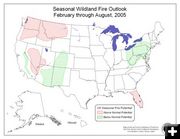

Fire Outlook
National wildland fire outlook for February through August, 2005. Graphic courtesy NIFC.
|
|
Wildfire Season has started in Wyoming
500 acre fire forces evacuation at Fort Washakie
April 17, 2005
A 500-acre wildfire burning on the Wind River Reservation near Lander has destroyed at least one building and forced the evacuation of Fort Washakie, according to morning news reports today. Approximately 100 firefighters are on the blaze that is in dry brush and being fueled by high winds. Residents reportedly were taken to a Red Cross shelter until it is safe to return.
Current Wildfires
Nationally, there have been 1,105 new fires as of Friday, April 15th, according to the National Interagency Fire Center (NIFC) daily Incident Management Situation Report. There were 14 new large fires reported. Seven new fires were in the Southern Area, six in the Eastern Area, and one in the Southwest Area.
Very high to extreme fire indices were reported in California, Montana, Minnesota, Wisconsin, Michigan, Pennsylvania, Vermont, Massachusetts and Texas. On the Custer National Forest in Montana there was a 600-acre fire that is now 100% contained.
Wildfire Outlook
According to NIFC, the areas with the highest fire potential this summer extends from the Cascades across Idaho and into Montana and northwest Wyoming. "This is primarily due to the very low snowpack and a warmer than normal spring forecast. However, there are still many unknowns such as the character of the snowmelt and summer lightning pattern," according to NIFC website’s Wildland Fire Outlook for February through August, 2005.
The preliminary outlook for this year’s fire season shows above normal fire potential in the Pacific Northwest, Northern Rockies, the lower elevations of the Great Basin and over much of Florida. Some key points of the upcoming season include:
- Mountain snowpacks are at or near record low levels in portions of Washington, Oregon, Idaho, Montana and northwest Wyoming. This combined with long term drought and vegetation mortality from insect damage will increase fire potential in portions of the West.
- Winter storms have brought heavy rain and snow in California, Colorado and the Southwest. This will help moderate the fire season in the mountains but will increase fire potential in the lower elevations of Nevada, Utah and the California deserts, due to heavier concentrations of fine fuels.
- Florida has been drier than normal so far this winter. This, combined with downed trees from the 2004 hurricanes, will lead to the potential for an active fire season.
- Predicting the Alaska fire season is very difficult this early in the year. However, preliminary indications point to a less active season compared to last year’s record breaking fire season.
Related Links:
National Interagency Fire Center (NIFC)
National Large Fire Daily Map
|
